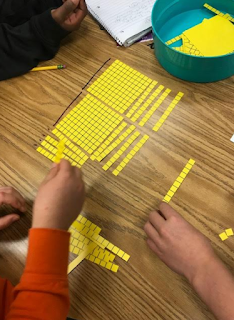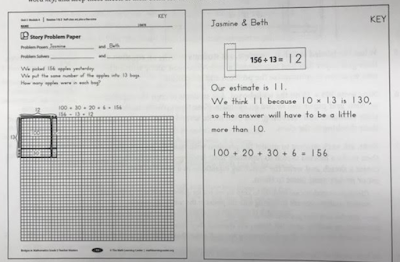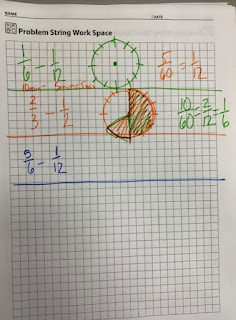The Randall Spelling Bee will be held on Thursday, January 9th at 1:30 p.m. The week before break we will be doing spelling bee rounds in our classrooms to determine who our representative and alternate will be. We will do five spelling bee rounds with the 1st, 2nd and 3rd place finishers earning points for each round. All students will have an opportunity to participate. Scoring will be as follows:
1st place = 5 points
2nd place = 3 points
3rd place = 1 point
After the five practice rounds the student with the most points will be our representative. The student with the second most points will be our alternate.
Have fun and good luck!
Friday, December 13, 2019
Writing
Our writing goal this quarter is to write Non-Fiction pieces. Our "I Can" statements include: I can write informative/explanatory tests to examine a topic and convey ideas and information clearly.
We will get to that goal by working on how to organize our writing, so our first lessons were on how to write complete and organized paragraphs. We learned about the three parts to a paragraph, the topic sentences, the detail sentences, and the concluding sentence. The following shows the process we went through to plan and draft our non-fiction writing. Students will be using these rough drafts to produce a picture book page about a chosen animal, that will all be combined to make a class book on animals. Pages will include not just their paragraphs but could also have illustrations, diagrams, maps, charts/graphs, glossary, titles/subtitles etc, which are often found within non-fiction text.
We will get to that goal by working on how to organize our writing, so our first lessons were on how to write complete and organized paragraphs. We learned about the three parts to a paragraph, the topic sentences, the detail sentences, and the concluding sentence. The following shows the process we went through to plan and draft our non-fiction writing. Students will be using these rough drafts to produce a picture book page about a chosen animal, that will all be combined to make a class book on animals. Pages will include not just their paragraphs but could also have illustrations, diagrams, maps, charts/graphs, glossary, titles/subtitles etc, which are often found within non-fiction text.
Bridges: Dividing using Place Value
Bridges: Division using Place Value
Students have been working this week on division of whole numbers using place value models, and base ten grid paper. This is a very new and complicated strategy, but we feel like after a few days students really started getting it. Here are some examples from the text, as well as some student work. Ask your child to explain how they used the base ten models.
Reading
We have finished up our Shared Reading experience with Number the Stars. They really loved the story, and I hope your child shared with you about it at home. If they haven't please ask them. It's a very moving story, and we spent time discussing how an author develops theme in the story. We explored how this author uses suspense, visualization, and character development to tell the story, and catch the reader. At the end of EVERY chapter, they were hungry for more.
We also discussed a lot of non-ficiton information about the Holocaust and read great picture books about many experiences of those who went through this terrible time in history. We also learned a lot about how the Danish people became real allies to their Jewish neighbors, and saved 90% of their Jewish population. Here is a link to a great non-fiction piece we shared with the students as part of our learning. Also here are some links to the great books we used to help us synthesize our learning and understanding.
https://www.history.com/news/wwii-danish-jews-survival-holocaust
https://www.goodreads.com/book/show/273794.The_Yellow_Star
http://www.ruthvanderzee.com/erikas-story, https://www.publishersweekly.com/978-1-56846-176-2
https://www.publishersweekly.com/978-0-439-43540-6, https://www.youtube.com/watch?v=SWHjMhutlws&disable_polymer=true
https://www.publishersweekly.com/978-0-15-202306-5
Next week students will work on a final project to show their understanding of the story and it's many themes.
After break we will work on non-fiction texts, with a focus o main ideas and details that support.
We also discussed a lot of non-ficiton information about the Holocaust and read great picture books about many experiences of those who went through this terrible time in history. We also learned a lot about how the Danish people became real allies to their Jewish neighbors, and saved 90% of their Jewish population. Here is a link to a great non-fiction piece we shared with the students as part of our learning. Also here are some links to the great books we used to help us synthesize our learning and understanding.
https://www.history.com/news/wwii-danish-jews-survival-holocaust
https://www.goodreads.com/book/show/273794.The_Yellow_Star
http://www.ruthvanderzee.com/erikas-story, https://www.publishersweekly.com/978-1-56846-176-2
https://www.publishersweekly.com/978-0-439-43540-6, https://www.youtube.com/watch?v=SWHjMhutlws&disable_polymer=true
https://www.publishersweekly.com/978-0-15-202306-5
Next week students will work on a final project to show their understanding of the story and it's many themes.
After break we will work on non-fiction texts, with a focus o main ideas and details that support.
Science
We have started a new science unit - Mixtures and Solutions. In this unit students will experiment with a variety of materials to see how they combine together. Throughout the unit we are also focusing on making detailed observations, keeping organized notes, making predictions and recording our outcomes. We began by combing a variety of fruits to make our first mixture!
We followed this up by experimenting to see if combining gravel, salt and diatomaceous earth with water would also create a mixture. We then discussed whether or not mixtures can be separated, and if so how. We used filters and evaporation as methods of separating mixtures. We have discussed and defined both mixtures and solutions. Every solution is a mixture, but not all mixtures are solutions. Ask your child an example of a mixture and a solution.
We explored the process of saturation, using both salt water solution and citric acid. We weighed our 50 mL of water before we added the materials, and then after to see how much salt or CA it would take to saturate the water.
We will also explore chemical reactions.
Monday, December 2, 2019
Hot Lunch Menu Going Green!
Starting this month the MMSD hot lunch menu will no longer be available in printed form. Here is the link to the menu site, which will change each month to reflect the new month's menu.
MMSDMenu
MMSDMenu
Tuesday, November 26, 2019
Bridges Unit 3: Decimals
In Unit 3 we have been working on developing our sense of decimals. What do tenths, hundredths, thousandths mean? What does that look like? How do we write those words, say those words, show those as numbers, etc. We have done work adding, subtracting and comparing decimals and thinking about what happens to decimals as we multiply and divide by powers of ten. We will continue this work a we do some conversions of metric units of measurements in the upcoming week. We are also working on rounding with decimals. We will have our Unit 3 Post Assessment the week before winter break.
Games to practice decimal place value and rounding:
Games to practice decimal place value and rounding:
Early Colonies
In social studies we have been studying the early English colonies. Students worked in groups to learn about the founding, the geography, the economy and the government of six different colonies: Massachusetts Bay, Rhode Island, New York, Georgia, Pennsylvania and Maryland. Then they created billboards and sales pitches to try to convince their peers to come to their colony. Ask your child about the qualities of their colony and their sales pitch!
Monday, November 25, 2019
Device Take Home
A set of purple papers came home on Friday about 5th graders bringing home their school issued Chromebooks. Hopefully, your student mentioned this to you. Those papers are due back on Friday, December 6th. There is the option to opt out of bringing it home, but then we still need the paper back stating such. Thanks everyone!
Monday, November 18, 2019
Sunday, November 10, 2019
Reading
This week we began working together on a shared reading unit. We have been reading Newbery Award winning book Number the Stars by Lois Lowry. See more about the book here, Number the Stars.
This shared reading experience is allowing the teachers to model how we want students to be responding to text. We will model many ways to respond, what good responses look like, as well as making things a little more challenging as the year progresses. The kinds of assignments include making connections, analyzing characters, vocabulary, summarizing, , questioning, , visualizing and most importantly finding the theme of the story. Check back for some examples of student work
This shared reading experience is allowing the teachers to model how we want students to be responding to text. We will model many ways to respond, what good responses look like, as well as making things a little more challenging as the year progresses. The kinds of assignments include making connections, analyzing characters, vocabulary, summarizing, , questioning, , visualizing and most importantly finding the theme of the story. Check back for some examples of student work
Friday, November 8, 2019
Writing
As the first quarter came to an end, so did our writing unit on Narratives. Students worked really, really hard on not just writing a story, but also revising a story.
After writing their first draft, students cut up the story into sections that could be paragraphs. Not all fifth graders write with paragraphs, so we worked on how to figure out when a new paragraph would start, and that we indent the first lines of paragraphs.
Once they'd cut it apart, they glued it into what we call a "Revision Booklet". The booklet allows students to make revisions/changes to the story with adequate space. We had many lessons about how students could improve their writing including writing better beginnings, using better words (including "Said is dead"), using dialogue, and using figurative language such as similes, metaphors or personification.
Here's an example of what a revision book looks like.
After writing their first draft, students cut up the story into sections that could be paragraphs. Not all fifth graders write with paragraphs, so we worked on how to figure out when a new paragraph would start, and that we indent the first lines of paragraphs.
Once they'd cut it apart, they glued it into what we call a "Revision Booklet". The booklet allows students to make revisions/changes to the story with adequate space. We had many lessons about how students could improve their writing including writing better beginnings, using better words (including "Said is dead"), using dialogue, and using figurative language such as similes, metaphors or personification.
Here's an example of what a revision book looks like.
You will have a chance to see your child's revision booklet at conferences on the 21st.
Once students were done revising, they met with a teacher to edit and refine before typing up their final drafts. Those will also be available for you at conferences.
Wednesday, October 30, 2019
Friday, October 25, 2019
How did Native Americans adapt to their environments?: Shelter
As part of our study of how Native Americans adapted to their environments we gave groups a chance to try to build a shelter that would represent that of the tribes they studied. Teachers gathered both natural and craft supplies and gave the students free reign to try anything. We had natural grasses, reeds, sticks and leaves, along with material, paper, craft sticks, straws, toothpicks and so much more. Check out their amazing work!
Subscribe to:
Comments (Atom)


















































